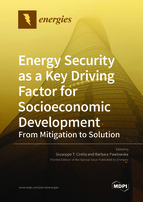Energy Security as a Key Driving Factor for Socioeconomic Development: From Mitigation to Solution
A special issue of Energies (ISSN 1996-1073). This special issue belongs to the section "C: Energy Economics and Policy".
Deadline for manuscript submissions: closed (30 September 2021) | Viewed by 19142
Special Issue Editors
Interests: sustainability in economic development; efficient and sustainable transport; external transport costs estimation; effectiveness of energy use; renewable energy resources; green and smart cities; transport policy; energy policy
Interests: geography; sustainability; environmental management; urban studies; social impact; economic development; green infrastructure
Special Issues, Collections and Topics in MDPI journals
Special Issue Information
Dear Colleagues,
Contemporary societies and economies from around the globe show an increasing demand for energy. Energy is the driving force behind development. As such, the future challenge will be not only to meet the rising demand but also implement less reliance on depleting fossil fuels which cause damage to the environment. Moreover, the sustainability of supplied energy requires a reduction of emissions to control the absorption capacity vis-à-vis the environment. Globally, policymakers have largely recognized the significance of the relationship between energy and economic progress. According to Indriyanto et al. (2010), policymakers usually consider the social and economic aspects of energy security in terms of affordability and accessibility of service. The conditions of socioeconomic development depend on safe, secure, and sustainable energy at affordable prices. One of the prime concerns of policy makers should be to ensure energy security in the country (Umbach, 2008). These factors result in an increasing interest in undertaking activities in developing renewable resources. Energy efficiency is treated as the most cost-effective way to reduce energy demand while maintaining stable economic activity. Some researchers have called this the “fifth fuel”, although it does not have much in common with the traditional sources of energy science (Yergin, 2013). Increasing energy efficiency is an important contributive aspect to solving issues in relation to climate change, energy security, and energy competitiveness. As a result, no country can afford to waste energy.
Another pressing challenge is the rapid economic development in the developing world, which is experiencing increases in energy consumption and demand for energy resources. This influx mostly considers energy conservation as a perceived additional cost and lowering of living standard. This standpoint has been considered an approach that denies people in these regions the opportunity to improve their living conditions and technological progress. The term “energy poverty” refers to the situation observed in developing countries. The lack of or limited access to modern energy services such as electrical power, and the negative effects on well-being associated with it (e.g., slow economic growth, low human development index, and high environmental impact) are the effects of energy poverty.
In line with these goals, the journal Energies is preparing this Special Issue entitled “Energy Security as a Key Driving Factor for Socioeconomic Development: From Mitigation to Solution”. We are inviting qualified scientists to participate and share their work with the international scientific community via this Special Issue. We aim to provide a picture of the global problem, and to explore it via case studies. This approach will help the scientific community and decision makers understand how best to tackle the global problem of energy security. The topics of interest for this Special Issue include but are not limited to:
- Energy efficiency models and simulation tools;
- Energy efficiency improvement tools;
- Energy security and development nexus;
- Building energy security;
- Transformation towards renewable energy sources;
- Impact of energy poverty on human development and the environment;
- Energy resource studies and exploitation barriers;
- Fossil fuel subsidies, fuel switching, and fuel stacking;
- Techno-economic assessment of energy supply solutions;
- Current and potential role of carbon-neutral technologies;
- Policy initiatives and recommendations for energy poverty mitigation;
- Country and community-based case studies.
Prof. Dr. Barbara Pawlowska
Prof. Dr. Giuseppe T. Cirella
Guest Editors
Manuscript Submission Information
Manuscripts should be submitted online at www.mdpi.com by registering and logging in to this website. Once you are registered, click here to go to the submission form. Manuscripts can be submitted until the deadline. All submissions that pass pre-check are peer-reviewed. Accepted papers will be published continuously in the journal (as soon as accepted) and will be listed together on the special issue website. Research articles, review articles as well as short communications are invited. For planned papers, a title and short abstract (about 100 words) can be sent to the Editorial Office for announcement on this website.
Submitted manuscripts should not have been published previously, nor be under consideration for publication elsewhere (except conference proceedings papers). All manuscripts are thoroughly refereed through a single-blind peer-review process. A guide for authors and other relevant information for submission of manuscripts is available on the Instructions for Authors page. Energies is an international peer-reviewed open access semimonthly journal published by MDPI.
Please visit the Instructions for Authors page before submitting a manuscript. The Article Processing Charge (APC) for publication in this open access journal is 2600 CHF (Swiss Francs). Submitted papers should be well formatted and use good English. Authors may use MDPI's English editing service prior to publication or during author revisions.
Keywords
- sustainable development
- energy security
- energy efficiency
- energy poverty
- sustainable energy
- renewable energy sources
- fossil fuels
- climate change
- energy prices
- fossil fuel subsidies
- energy policy tools
- energy demand and supply
- energy management







